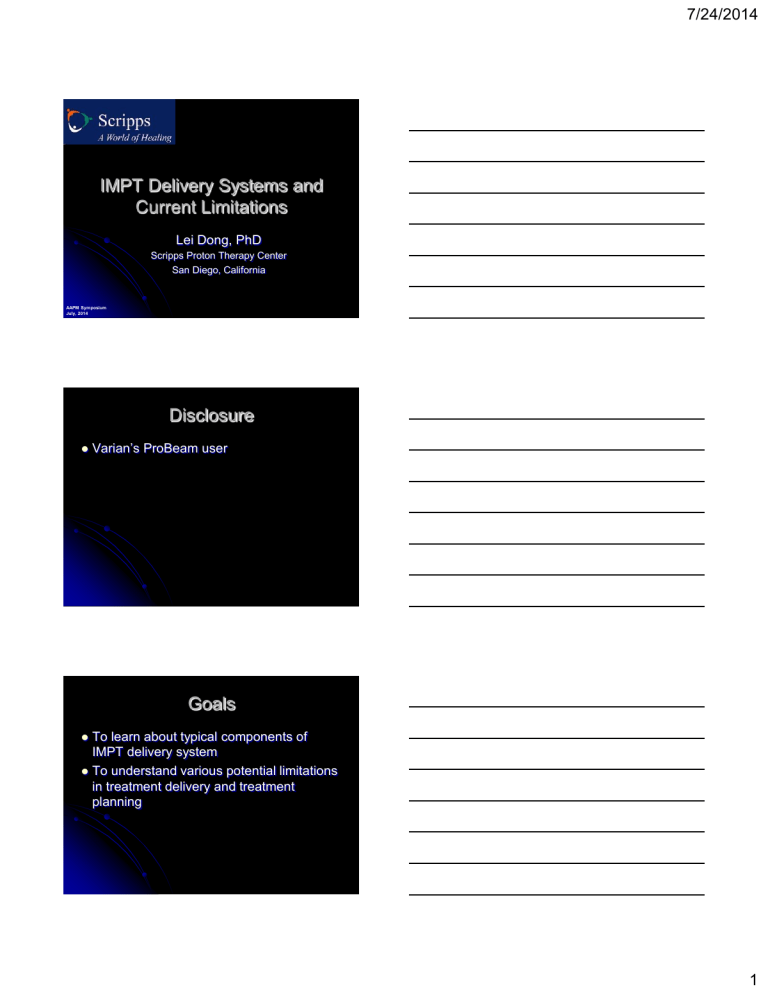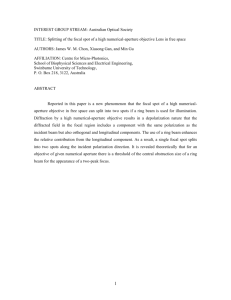IMPT Delivery Systems and Current Limitations Disclosure Goals

IMPT Delivery Systems and
Current Limitations
Lei Dong, PhD
Scripps Proton Therapy Center
San Diego, California
AAPM Symposium
July, 2014
Disclosure
Varian’s ProBeam user
Goals
To learn about typical components of
IMPT delivery system
To understand various potential limitations in treatment delivery and treatment planning
7/24/2014
1
Pencil Beam Scanning
4
Scripps Proton Therapy Center Layout
Beamline
Accelerator
Nozzle
Beam Exit
2/3 speed of light
Five Treatment Rooms
3 – Isocentric Gantry Rooms
2 – Fixed beam rooms
Dong/SPTC
Cyclotron
Alternating Radio Frequency (RF) voltage accelerates protons when they go across the gap in each turn.
L. Dong
7/24/2014
2
Varian/ Accel’s Superconducting Cyclotron
Current Modulation
7/24/2014
3
7/24/2014
PTC-H 250 MeV
Synchrotron Ring
Scanning beam timing chart
Smith et al . Med Phys 2009
4
AAPM 2010 Abstract
What is the maximum number of beam spots deliverable within one gating window for synchrotron based scanning proton beam therapy of lung cancer?
Yoshikazu Tsunashima 1 , Sastry Vedam 2 , Lei Dong 2 , Masumi
Umezawa 3 , Xiaodong Zhang 2 , Peter Balter 2 and Radhe Mohan 2
1. Graduate School of Biomedical Sciences, University of Texas at Houston
2. Department of Radiation Physics, MD Anderson Cancer Center
3. Hitachi Ltd., Energy and Environmental Systems Laboratory
Key Result
Number of spots (average) delivered within one expiration phase from simulation results vs. Number of spots from treatment plan
Number of spots
Maximum number of spots/layer whose plot within
σ from the line
85 spots 30 %DC threshold
83 spots 20 %DC threshold
77 spots 10 %DC threshold
Cyclotron vs. Synchrotron
Energy:
Degrader
70 – 250 MeV
Energy:
On-demand acceleration
70 – 250 MeV
Energy resolution:
~ 0.1 MeV
Beam current
300 – 800 nA
Intensity Modulation
Vertical deflector
Cycle time
Continuous (50 MHz)
Energy resolution:
~ 0.1 MeV (94 energies)
Beam current
300 – 800 nA
Intensity Modulation
Modulated @ 1000 Hz; duty cycle 0.2%
Cycle time
~ 2 seconds
7/24/2014
5
Beam Steering by Magnetic Fields
Quadruples
• Dipoles: for bending the beam
• Quadruples: focusing the beam
• Vacuum pumps to keep beamline under very high level of vacuum
(think about outer space)
• Beam profile monitors to measure beam along the central tube Dipoles
16
Beamline
17
Changing Field Strength and
Managing Residual Magnetic Field
7/24/2014
6
Beam Delivery System
Nozzle
Lateral scanning system
Position monitoring system
Dose monitoring system
Accessory holders (range shifter and aperture)
Imaging (optional)
Scanning System Challenges
Power requirements
Faster scans and large fields require high power (>1000A)
Raster vs. Spot Scanning
High precision is required for magnetic field
Gantry dependence
Position monitoring at low dose rate
Preferred fast scan direction to minimize breathing motion
Variations in proton scanned beam dose delivery due to uncertainties in magnetic beam steering
Stephen Peterson and Jerimy Polf et al.
Variations in
Magnetic field
Strength ∆B
Analytical
Displacement of spot lateral positions: ∆s
Empirical
Dose delivery
Uncertainties in Patient: ∆D
Med. Phys. 36 (8), 2009
7/24/2014
7
Variations in magnetic field strength leads to fluctuations in the steering of the pencil beams to their intended final position.
Analytical formula between magnet strength and lateral spot position
Magnetic steering beam position relationship: physics
Y-direction magnet
Find the function mapping magnet strength to beam position:
Lorentz and centripetal force:
Relativity effect:
Relativistic mass:
Results
7/24/2014
8
Position Monitor
Multi Strip Ionization Chamber (MSIC) or two-dimensional multi-wire system is used to monitor spot position and spot shape
Minimum MU per Spot
To accurately measure spot position and shape
Delayed charge – delay of the beam termination
Beamline activation at high energy
(MDACC) Upper limit: Safety consideration – limit the maximum dose per spot
Impact of Scan Direction
Experiment
Beam delivery
• Field
• Spot spacing
• Number of spot
• Spot duration time
• One layer time
• Scan directions
Tsunashima et al.
10cm x10cm field
8mm (x and y direction)
13 x 13=169 spots ( ≡ one painting)
7ms/spot (4ms delivery+3ms moving)
169x7ms=1.2 s (one painting)
Orthogonal and Parallel to Motion
Phantom
Motion
7/24/2014
9
Phase-
Results
Orthogonal scan T=3 s
Painting x1
Phase+
Phase-
A=3mm A=5mm A=10mm A=20mm
Phantom motion
Reference:
10x10 cm 2 field
Spot spacing 8mm
169 spots
T=3 s
Painting x2
1.18 s for delivery
T=3 s
No repainting
Painting x4
Tsunashima et al.
Phase+
Phase-
A=3mm
Phase+
A=5mm A=10mm A=20mm
Phase- Results
Parallel scan T=3 s
Painting x1
Phase+
Phase-
A=3mm A=5mm A=10mm A=20mm
Phantom motion
Reference:
10x10 cm 2 field
Spot spacing 8mm
169 spots
T=3 s
Painting x2
1.18 s for delivery
T=3 s
No repainting
Painting x4
Tsunashima et al.
Phase+
Phase-
A=3mm
Phase+
A=5mm A=10mm A=20mm
Spot Size Issue
7/24/2014
10
Photons vs. Future Protons
Bortfeld T. IMRT: “A review and a preview”, Phys. Med. Biol. 51(13), 2006.
Impact of Spot Size to Planning Quality
Widesott et al. Med. Phys. 39 (3) 2012
H&N PTV 66 Gy
7/24/2014
11
Conclusions
Summary:
Why is PBS Possible Today?
• Better power supply for magnets (dipole; quadruple; fast scanning coils)
• More advanced accelerator technology
– More efficient accelerator
– Better beam optics (smaller spots)
– Fast energy change and current modulation
– Automatic beam tuning and control system
– Better and faster electronic circuits
LD 04/13
7/24/2014
12






